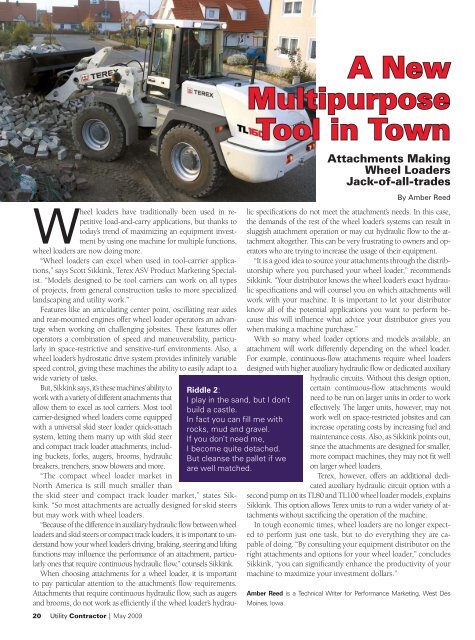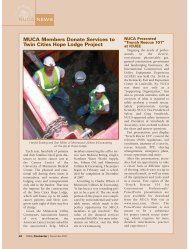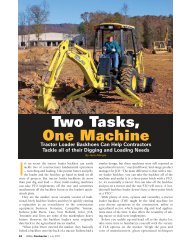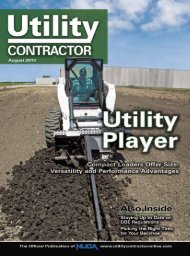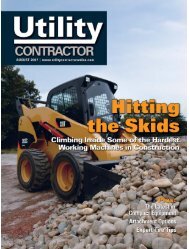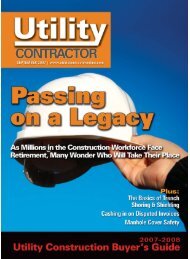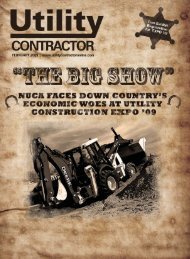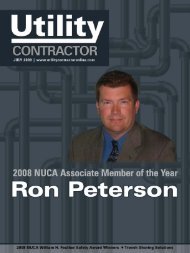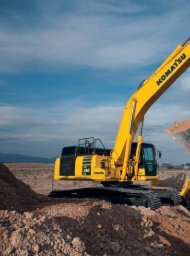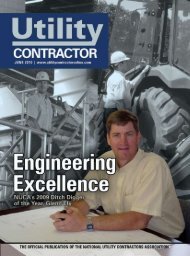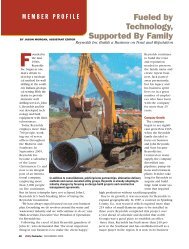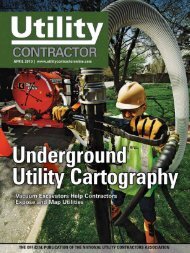View Full May PDF Issue - Utility Contractor Online
View Full May PDF Issue - Utility Contractor Online
View Full May PDF Issue - Utility Contractor Online
You also want an ePaper? Increase the reach of your titles
YUMPU automatically turns print PDFs into web optimized ePapers that Google loves.
Wheel loaders have traditionally been used in repetitive<br />
load-and-carry applications, but thanks to<br />
today’s trend of maximizing an equipment investment<br />
by using one machine for multiple functions,<br />
wheel loaders are now doing more.<br />
“Wheel loaders can excel when used in tool-carrier applications,”<br />
says Scott Sikkink, Terex ASV Product Marketing Specialist.<br />
“Models designed to be tool carriers can work on all types<br />
of projects, from general construction tasks to more specialized<br />
landscaping and utility work.”<br />
Features like an articulating center point, oscillating rear axles<br />
and rear-mounted engines offer wheel loader operators an advantage<br />
when working on challenging jobsites. These features offer<br />
operators a combination of speed and maneuverability, particularly<br />
in space-restrictive and sensitive-turf environments. Also, a<br />
wheel loader’s hydrostatic drive system provides infinitely variable<br />
speed control, giving these machines the ability to easily adapt to a<br />
wide variety of tasks.<br />
But, Sikkink says, it’s these machines’ ability to<br />
work with a variety of different attachments that<br />
allow them to excel as tool carriers. Most tool<br />
carrier-designed wheel loaders come equipped<br />
with a universal skid steer loader quick-attach<br />
system, letting them marry up with skid steer<br />
and compact track loader attachments, including<br />
buckets, forks, augers, brooms, hydraulic<br />
breakers, trenchers, snow blowers and more.<br />
“The compact wheel loader market in<br />
North America is still much smaller than<br />
20 <strong>Utility</strong> <strong>Contractor</strong> | <strong>May</strong> 2009<br />
Riddle 2:<br />
I play in the sand, but I don’t<br />
build a castle.<br />
In fact you can fill me with<br />
rocks, mud and gravel.<br />
If you don’t need me,<br />
I become quite detached.<br />
But cleanse the pallet if we<br />
are well matched.<br />
A New<br />
Multipurpose<br />
Tool in Town<br />
Attachments Making<br />
Wheel Loaders<br />
Jack-of-all-trades<br />
By Amber Reed<br />
the skid steer and compact track loader market,” states Sikkink.<br />
“So most attachments are actually designed for skid steers<br />
but may work with wheel loaders.<br />
“Because of the difference in auxiliary hydraulic flow between wheel<br />
loaders and skid steers or compact track loaders, it is important to understand<br />
how your wheel loader’s driving, braking, steering and lifting<br />
functions may influence the performance of an attachment, particularly<br />
ones that require continuous hydraulic flow,” counsels Sikkink.<br />
When choosing attachments for a wheel loader, it is important<br />
to pay particular attention to the attachment’s flow requirements.<br />
Attachments that require continuous hydraulic flow, such as augers<br />
and brooms, do not work as efficiently if the wheel loader’s hydraulic<br />
specifications do not meet the attachment’s needs. In this case,<br />
the demands of the rest of the wheel loader’s systems can result in<br />
sluggish attachment operation or may cut hydraulic flow to the attachment<br />
altogether. This can be very frustrating to owners and operators<br />
who are trying to increase the usage of their equipment.<br />
“It is a good idea to source your attachments through the distributorship<br />
where you purchased your wheel loader,” recommends<br />
Sikkink. “Your distributor knows the wheel loader’s exact hydraulic<br />
specifications and will counsel you on which attachments will<br />
work with your machine. It is important to let your distributor<br />
know all of the potential applications you want to perform because<br />
this will influence what advice your distributor gives you<br />
when making a machine purchase.”<br />
With so many wheel loader options and models available, an<br />
attachment will work differently depending on the wheel loader.<br />
For example, continuous-flow attachments require wheel loaders<br />
designed with higher auxiliary hydraulic flow or dedicated auxiliary<br />
hydraulic circuits. Without this design option,<br />
certain continuous-flow attachments would<br />
need to be run on larger units in order to work<br />
effectively. The larger units, however, may not<br />
work well on space-restricted jobsites and can<br />
increase operating costs by increasing fuel and<br />
maintenance costs. Also, as Sikkink points out,<br />
since the attachments are designed for smaller,<br />
more compact machines, they may not fit well<br />
on larger wheel loaders.<br />
Terex, however, offers an additional dedicated<br />
auxiliary hydraulic circuit option with a<br />
second pump on its TL80 and TL100 wheel loader models, explains<br />
Sikkink. This option allows Terex units to run a wider variety of attachments<br />
without sacrificing the operation of the machine.<br />
In tough economic times, wheel loaders are no longer expected<br />
to perform just one task, but to do everything they are capable<br />
of doing. “By consulting your equipment distributor on the<br />
right attachments and options for your wheel loader,” concludes<br />
Sikkink, “you can significantly enhance the productivity of your<br />
machine to maximize your investment dollars.”<br />
Amber Reed is a Technical Writer for Performance Marketing, West Des<br />
Moines, Iowa.


